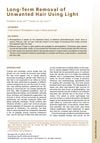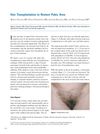TLDR Modern beauty standards encourage women to remove pubic hair for aesthetic and social reasons.
The study demonstrated that the removal of female pubic hair, a common practice in the early 21st century, resulted from changes in fashion and marketing strategies by manufacturers of hair removal products. It explored historical precedents, cultural practices, and contemporary reasons for this trend. The conclusion was that the modern female beauty ideal involved body modification to achieve smooth, hairless skin, which society viewed as normative for aesthetic, hygienic, erotic, and self-image reasons.
143 citations
,
January 2013 in “Dermatologic surgery” In-office laser hair removal works well long-term, especially Nd:YAG for darker skin, but home devices need more testing.
 25 citations
,
October 2012 in “Dermatologic clinics”
25 citations
,
October 2012 in “Dermatologic clinics” Laser and light treatments can effectively remove hair long-term.
 3 citations
,
January 2010 in “Expert Opinion on Pharmacotherapy”
3 citations
,
January 2010 in “Expert Opinion on Pharmacotherapy” No treatment fully stops excessive hair growth in women, but various methods can help manage it effectively.
 4 citations
,
February 2008 in “Dermatologic Surgery”
4 citations
,
February 2008 in “Dermatologic Surgery” Hair transplant surgery successfully restored a woman's pubic hair, improving her appearance and satisfaction.
41 citations
,
April 2006 in “Journal of Pediatric and Adolescent Gynecology” Shaving caused a mild, itchy pubic rash with small bumps and crusts.
 12 citations
,
January 2006 in “Aesthetic Plastic Surgery”
12 citations
,
January 2006 in “Aesthetic Plastic Surgery” Micrografts can effectively restore pubic hair, and using the right technique is crucial for natural-looking results.



